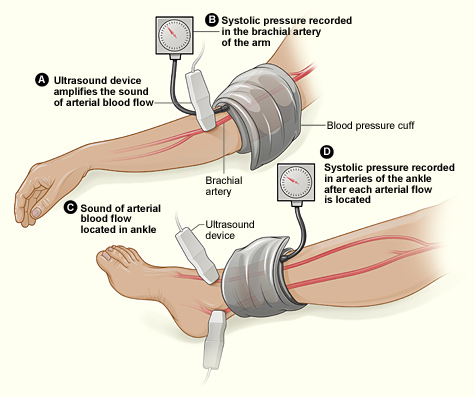


The ankle-brachial index (ABI) is a simple, reliable means for diagnosing PAD. Blood pressure measurements are taken at the arms and ankles using a pencil shaped ultrasound device called a Doppler. A Doppler instrument produces sound waves (not x-rays) and is considered noninvasive because it does not require the use of needles or catheters. The ABI test is simple enough to be performed in any doctor's office or vascular laboratory. Not only is the ABI one of the most reliable tests for PAD, it is also the least expensive
Why it is done
In a perfectly healthy circulatory system, blood pressure measured at the brachial artery in the crook of the arm (which is near the heart) is a good gauge of blood pressure elsewhere in the body. But when blood must travel through stiff or cholesterol-clogged arteries, the pressure at sites further from the heart can differ from that in the arm. The ankle-brachial index, sometimes called the arm-ankle index, compares blood pressure from two locations. A large difference between the two can signal the presence of peripheral artery disease. The test can also track the progression of the disease or the effect of treatment.

Further Reading
What is Peripheral Vascular Disease? American Heart Association
Warning
Signs of
Heart Attack? American Heart Association
Warning Signs of Stroke? American Heart Association
Heart Disease and Stroke? American Heart Association
Who needs it?
Anyone with symptoms of peripheral artery disease should have an ankle-brachial index test. The most common sign of this condition is pain or cramping in the calves, thighs, hips, or buttocks when walking, climbing stairs, or exercising that fades with rest. Doctors call this claudication. Wounds on the toes, feet, or legs that don’t heal or take a long time to heal are another sign. So is a leg that feels cooler to the touch than other parts of the body, or that looks to be a different shade.
Peripheral artery disease, like coronary artery disease, often doesn’t cause symptoms until it is advanced. So an ankle-brachial index is also recommended for people at high risk of developing the disease. This includes smokers or former smokers over age 50; adults with diabetes, high blood pressure, or high cholesterol; those who have had a stroke or mini-stroke; and anyone with a strong family history of heart disease.
What’s the procedure?
Having an ankle-brachial test takes 10 to 15 minutes. It can be done in a doctor’s office and doesn’t require any preparation other than removing your shoes and socks.
You lie quietly on an examination table for a few minutes. A doctor or nurse measures the pressure in both of your arms using a standard blood pressure cuff. He or she then measures the pressure in the posterior tibial artery and the dorsalis pedis artery near each ankle using a pressure cuff and a stethoscope or an ultrasound probe.
The highest pressure recorded at the ankle is divided by the highest pressure recorded at the brachial artery. This gives the ankle-brachial index.
Sometimes the measurements are made before and after exercising.
What it shows
The normal range for the ankle-brachial index is between 0.90 and 1.30. An index under 0.90 means that blood is having a hard time getting to the legs and feet: 0.41 to 0.90 indicates mild to moderate peripheral artery disease; 0.40 and lower indicates severe disease.
An ankle-brachial index over 1.30 is usually a sign of stiff, calcium-encrusted arteries. These often occur in people with diabetes or chronic kidney disease. In such cases, blood pressure should be measured at the toe, where arteries are less likely to be rigid.
Online ABI Calculator - Click to Use


How to Perform An ABI Test - Click to Use
ABI Worksheet - Click to Use